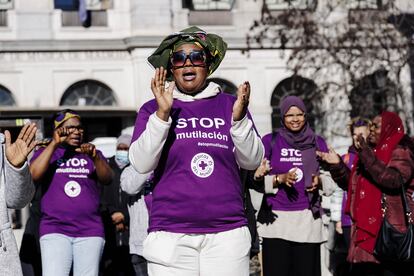WHO measures to curb the "growing medicalization" of female genital mutilation


Although it is recognized as a human rights violation and prohibited in many countries, there are currently more than 230 million girls and women worldwide who have undergone female genital mutilation (FGM), according to a UNICEF report published in 2024. Of these, some 52 million, approximately one in four female genital mutilation survivors , were mutilated by health professionals.
The World Health Organization (WHO) warned this Monday of the "growing medicalization" of FGM , with evidence indicating that it is "increasingly performed by health personnel." It emphasized the need to establish "urgent measures" to curb this practice. Therefore, it has published a new guideline aimed , among other things, at involving health workers in the prevention and prohibition of female genital mutilation.
Medicalized FGM, the total or partial mutilation of female genitals performed by healthcare professionals, not only violates medical ethics but also risks legitimizing the practice and giving the impression that it has no consequences. "Some studies suggest that it may be even more dangerous when performed by healthcare professionals, as it can cause deeper and more severe cuts," warns the WHO.
The document, titled Prevention of Female Genital Mutilation and Clinical Management of Its Complications, expands on guidelines published in 2016 and establishes eight recommendations and three statements of good practice.
Research shows that healthcare workers can be influential in changing attitudes toward FGM and play a crucial role in its prevention.
Christina Pallitto, scientist at the WHO and the United Nations Special Programme on Human Reproduction
Among the WHO's suggestions is training health care workers in FGM prevention, with actions ranging from refusing requests to perform it to informing the public about the short- and long-term risks. "Research shows that health care workers can be influential in changing attitudes toward FGM and play a crucial role in its prevention," said Christina Pallitto, a WHO and HRP scientist who led the development of the new guideline.
Furthermore, training in the management of health complications related to FGM is also recommended, as is the need to implement professional codes of conduct "with a zero-tolerance approach" that expressly prohibit healthcare personnel from performing this practice. "The involvement of doctors, nurses, and midwives should be a key element in the prevention of and response to FGM," Pallitto emphasized.
“The health sector plays an essential role in preventing female genital mutilation: health workers must be agents of change, not perpetrators of this harmful practice, and they must also provide high-quality health care to those who suffer its effects,” explained Dr. Pascale Allotey, Director of Sexual and Reproductive Health and Research at WHO and the UN Special Programme on Human Reproduction (HRP), in a press release.
The WHO document also covers "the education of women and girls living with or at risk of FGM, as well as men and boys in communities where it is practiced." These measures include group and individual health education, as well as counseling on FGM prevention aimed at promoting changes in attitudes toward this practice, which violates women's rights.
Female genital mutilation can lead to serious short- and long-term health complications. Adult women who underwent cutting as children are more likely to experience infertility and complications during childbirth. It can also lead to mental health problems. Therefore, the guide includes several clinical recommendations to "ensure access to high-quality, empathetic health care for survivors of FGM." These include mental health interventions for girls and women experiencing anxiety, depression, or post-traumatic stress disorder, and surgical and non-surgical sexual health interventions for those experiencing sexual dysfunction.
Today, a girl is one-third less likely than 30 years ago to undergo female genital mutilation, according to UNICEF. However, if the Sustainable Development Goals target of ending the practice by 2030 is to be met, progress must accelerate. The reduction should be 27 times faster than that observed in the last decade, according to data collected by the United Nations Children's Fund. Today, the largest number of female genital mutilation cases occur in African countries, with 144 million, followed by Asia (80 million) and the Middle East (6 million). Female genital mutilation is also practiced in small, isolated communities and among diasporas around the world.
EL PAÍS





